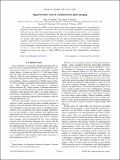| dc.contributor.author | Erkmen, Baris I. | |
| dc.contributor.author | Shapiro, Jeffrey H. | |
| dc.date.accessioned | 2010-02-12T18:05:46Z | |
| dc.date.available | 2010-02-12T18:05:46Z | |
| dc.date.issued | 2009-02 | |
| dc.date.submitted | 2008-09 | |
| dc.identifier.issn | 1094-1622 | |
| dc.identifier.issn | 1050-2947 | |
| dc.identifier.uri | http://hdl.handle.net/1721.1/51747 | |
| dc.description.abstract | The signal-to-noise ratios (SNRs) of three Gaussian-state ghost-imaging configurations—distinguished by the nature of their light sources—are derived. Two use classical-state light, specifically a joint signal-reference field state that has either the maximum phase-insensitive or the maximum phase-sensitive cross correlation consistent with having a proper P representation. The third uses nonclassical light, in particular an entangled signal-reference field state with the maximum phase-sensitive cross correlation permitted by quantum mechanics. Analytic SNR expressions are developed for the near-field and far-field regimes, within which simple asymptotic approximations are presented for low-brightness and high-brightness sources. A high-brightness thermal-state (classical phase-insensitive state) source will typically achieve a higher SNR than a biphoton-state (low-brightness, low-flux limit of the entangled-state) source, when all other system parameters are equal for the two systems. With high efficiency photon-number-resolving detectors, a low-brightness, high-flux entangled-state source may achieve a higher SNR than that obtained with a high-brightness thermal-state source. | en |
| dc.description.sponsorship | W. M. Keck Foundation Center for Extreme Quantum Information Theory | en |
| dc.description.sponsorship | Army Research Office MURI Grant | en |
| dc.description.sponsorship | DARPA Quantum Sensors Program | en |
| dc.language.iso | en_US | |
| dc.publisher | American Physical Society | en |
| dc.relation.isversionof | http://dx.doi.org/10.1103/PhysRevA.79.023833 | en |
| dc.rights | Article is made available in accordance with the publisher's policy and may be subject to US copyright law. Please refer to the publisher's site for terms of use. | en |
| dc.source | APS | en |
| dc.title | Signal-to-noise ratio of Gaussian-state ghost imaging | en |
| dc.type | Article | en |
| dc.identifier.citation | Erkmen, Baris I., and Jeffrey H. Shapiro. “Signal-to-noise ratio of Gaussian-state ghost imaging.” Physical Review A 79.2 (2009): 023833. © 2009 The American Physical Society. | en |
| dc.contributor.department | Massachusetts Institute of Technology. Research Laboratory of Electronics | en_US |
| dc.contributor.approver | Shapiro, Jeffrey H. | |
| dc.contributor.mitauthor | Erkmen, Baris I. | |
| dc.contributor.mitauthor | Shapiro, Jeffrey H. | |
| dc.relation.journal | Physical Review A | en |
| dc.eprint.version | Final published version | en |
| dc.type.uri | http://purl.org/eprint/type/JournalArticle | en |
| eprint.status | http://purl.org/eprint/status/PeerReviewed | en |
| eprint.grantNumber | W911NF-05-1-0197 | en |
| dspace.orderedauthors | Erkmen, Baris; Shapiro, Jeffrey | en |
| dc.identifier.orcid | https://orcid.org/0000-0002-6094-5861 | |
| mit.license | PUBLISHER_POLICY | en |
| mit.metadata.status | Complete | |
